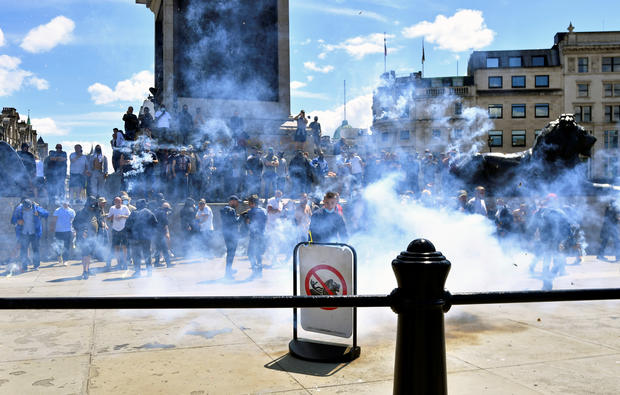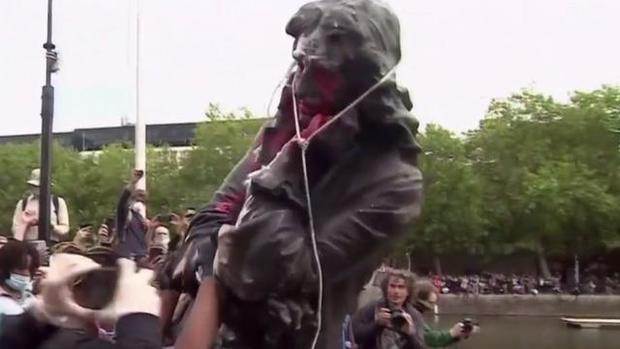London’s Metropolitan Police said Saturday night that six officers sustained minor injuries after being attacked by protesters. Five people were arrested on charges that included violent disorder, assault on police, possession of an offensive weapon, possession of drugs and/or drunk and disorderly conduct.
Met Commander Bas Javid said thousands congregated in London on Saturday. BBC News reported the groups included far-right activists claiming they were protecting statues from anti-racism activists, who also descended on London.
Prime Minister Boris Johnson tweeted “racist thuggery has no place on our streets” after officers were seen being punched and kicked.
According to BBC News, protesters gathered around the Cenotaph war memorial on Whitehall and the boarded-up statue of Winston Churchill in Parliament Square. There were a number of clashes with police in riot gear as crowds — chanting “England” and raising their arms — surged toward lines of officers.
Some protesters managed to break metal barriers around the Cenotaph while hurling flag poles, a smoke flare and a traffic cones towards police who were striking them back with batons. Large groups of right-wing protesters then moved to Trafalgar Square, where fireworks were thrown across the crowds.
A man who appeared to be part of the protest was pictured in Parliament Square urinating next to the memorial of PC Keith Palmer, the police officer killed in the Westminster terror attack in 2017, BBC News reported. Home Secretary Priti Patel said the “desecration” of the memorial was “utterly shameful.”
Police in London placed strict limits on protesters ahead of the demonstrations. The restrictions by the Metropolitan Police applied to Black Lives Matter protesters, and to left and right-wing groups that have notified the force of their intention to hold rallies in the capital. Groups have been told they must stick to specific routes and all events must end at 5:00 p.m. BST.
Javid earlier warned protesters to reconsider gathering at all due to the coronavirus pandemic saying, “we are asking you not to come to London, and let your voices be heard in other ways.”
Hundreds of far-right activists have stated they plan to surround colonial-era statues, which have become a lightning rod for debate and defacement over the past week.
Across the U.K. are dozens of monuments to those who traded in, and profited from, the transatlantic slave trade – a dark history long ignored by schools and political leaders that came crashing into the open last weekend. Protesters who took to the streets following the killing of George Floyd pulled a statue of Edward Colston from its plinth, dragged it through the streets and threw it into Bristol harbor.
Despite Colston’s prominence in the city, few knew he made his extravagant 17th century fortune by forcibly transporting over 100,000 Africans across the Atlantic. Historical records show at least 18,000 died under his watch during the months-long sea journey, often in chains.
It’s an uncomfortable truth about historic figures immortalized in steel and stone that Oxford University is also being forced to confront. Protesters are demanding a statue of Cecil Rhodes be removed from one of its colleges. The British imperialist’s policies on racial segregation led to the establishment of apartheid in South Africa.
Rhodes’ figure still peers from its perch at his alma mater, and the prestigious Rhodes Scholarship, which has helped many students, including former President Clinton, still remains in his name.
Activist and Black Lives Matter protest organizer Zealous G says it can no longer be ignored.
“I believe that this statue is a symbol of injustice and a constant reminder of what the U.K., U.S., France and all other empires have taken from our black communities,” Zealous G said. “A statue is put there to symbolize a person that you should idolize. A statue is put there for somebody you look up to. But we shouldn’t be looking up to people like that. It’s not about removing all history, it’s not about erasing it. It’s about learning from it.”
The mayor of London, Sadiq Khan, has also announced a review of all the capital’s statues and street names, saying any with links to slavery “should be taken down.”
One monument has already been removed. The likeness of the notorious slaveholder Robert Milligan was carted away from his perch outside the Museum of London Docklands earlier this week.
But after “racist” was scrawled on a Churchill statue during demonstrations over the killing of George Floyd, Johnson took to Twitter to accuse protesters of seeking to “censor our past.” The monument to Churchill has now been covered in a steel box to prevent it from being vandalized, something Johnson described as “absurd and shameful.”
Although Churchill is regarded by many Britons as one of its greatest leaders who helped defeat the Nazis in World War II, to others his well-documented racism led to atrocities. He openly stated he thought black people were inferior to whites, and described those from India as “a beastly people with a beastly religion.”
Historical documents also show Churchill supported policies that directly contributed to the Bengal famine, where up to three million people died of starvation under his watch.
All of this has led to a polarized debate about who to memorialize in a nation that rarely confronts its imperialist past, said academic and activist Patrick Vernon.
“Britain for the average person in Britain, they do not comprehend, or understand, or even know about the empire’s history, their colonial history,” he said.
“All the major cities, London, Liverpool, Bristol, were based on slave money. It’s a part of that history which unfortunately people don’t want to talk about. And for a very long time we’ve not had a proper debate about Britain’s past… Because you can remove all the statues but the system’s still there,” Vernon said. “It’s about how we educate, how we inform, the role of media, the role of politics to make sure that we have a proper inclusive society. And that’s why black lives matter.”



